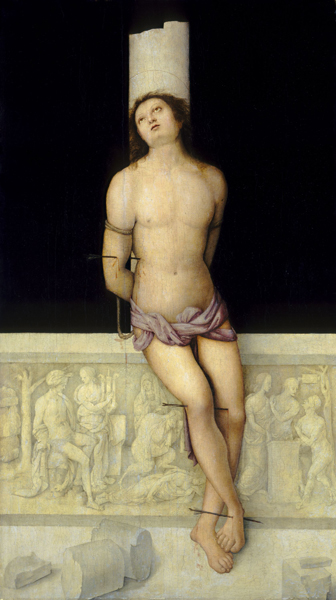Saint Sebastian

Amico Aspertini
Saint Sebastian, c. 1505
Oil on panel, 114.9 x 66 cm (45 1/4 x 26 in.)
National Gallery of Art, Washington, DC, Samuel H. Kress Collection
Image courtesy of the Board of Trustees, National Gallery of Art
Explain that the painting represents Saint Sebastian, a Christian condemned to death by the Roman emperor Diocletian. Sebastian miraculously survived execution by arrows.
1) Q: What visual evidence suggests the impact of classical artifacts on this painting?
A: Responses might include:
- Bas-relief with mythological imagery
- Column and fragments
- Drapery
- Nudity
- Idealization of the male body
2) Q: In what respects has the body been idealized?
A: Responses might include:
- Youthfulness
- A pose that accentuates sensuousness and curves
- Pleasing proportions
- Athletic build; slender yet muscular
- Smooth, hairless skin
- Placid expression; no evidence of mental or physical suffering
- Beautiful, rather feminine facial features
3) Q: What purpose does the bas-relief serve?
A: Responses might include:
- Appeals to the Renaissance taste for classical antiquity
- Establishes the approximate date and location of the scene (Roman Empire)
- Makes analogies between Saint Sebastian and ideal nudes in sculpture
- Scene of mourning reinforces tragic mood
- Contrasts pagan mythology with Christian religion
- Accentuates artist’s skill in simulating and differentiating materials (i.e., human body made of flesh vs. human body made of marble)
4) Q: Renaissance artists often employed the broken column to symbolize the virtue of fortitude — here, Sebastian’s miraculous fortitude in withstanding the assault by Diocletian’s archers. What other meaning(s) might the broken column and fallen fragments convey in this painting?
A: Responses might include:
- Saint Sebastian’s broken body
- A life cut short
- The decline and fall of imperial Rome
- Foreshadowing the ubiquity of antique fragments and ruins in Renaissance Rome